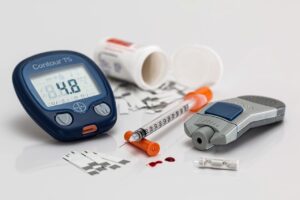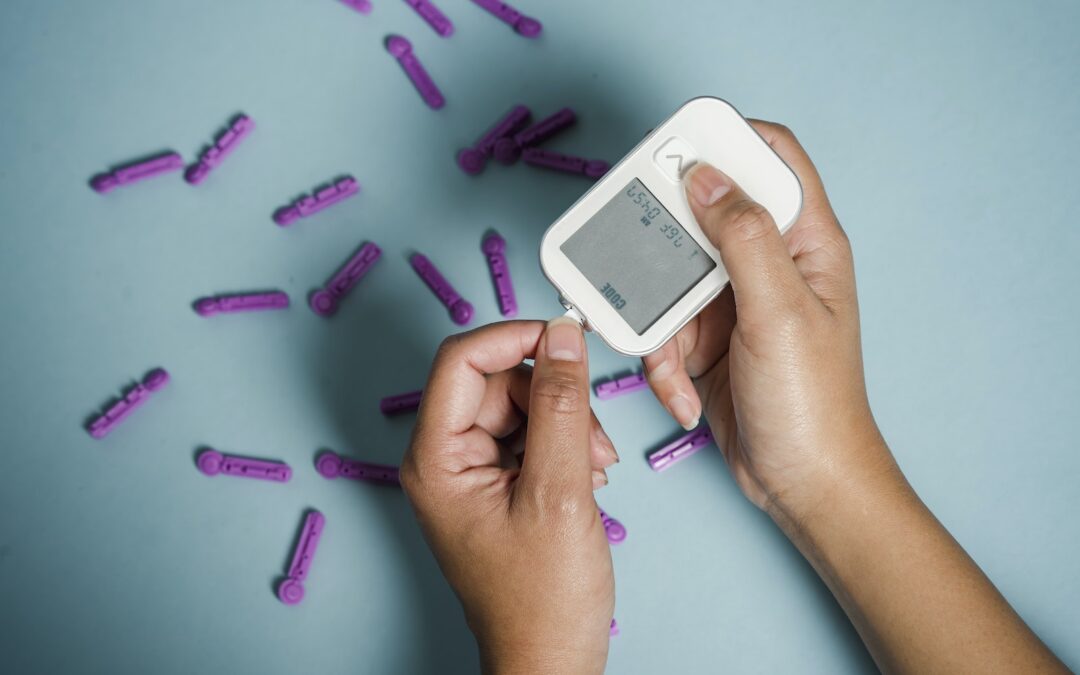
by I Dance With Diabetes | Dec 22, 2022 | Prevention
Planning the Perfect Diabetes Holiday? Create a Well-balanced Meal Plan with These Tips
We all know the challenge of being good during the holidays. All those cookies, desserts, drinks, etc. You know they’re not good for you, but just a little bit and it will be okay, right. It becomes so easy to have just one more, well maybe a second. The following article is the tip of the iceberg. It’s starting to live with diabetes.
Managing diabetes requires constant attention to diet and lifestyle changes in order to keep blood sugar levels as close to normal as possible.
So read on and learn to enjoy the holidays. The holiday season is a time for celebration, good food, and happy memories.

Intro: Tips for Planning a Diabetes-Friendly Holiday
When it comes to planning a diabetes-friendly holiday, the first thing that needs to be done is to speak to a doctor. The doctor will know what specific requirements are needed in order for you to enjoy yourself during the holidays.
The next step is to plan the food and drink intake. It is important you know how many carbohydrates you should be allowed on a daily basis and what foods you can eat. This will help you avoid any unpleasant surprises when it comes time for dinner or a snack break.
Finally, it is important for you to have regular blood tests done when you are away from home so that your medication dosage can be adjusted if necessary.
Planning a holiday can be stressful. But if you’re traveling with someone with diabetes, it can be even more so.
We have created this article to provide some helpful tips on how to plan a diabetes-friendly holiday.
Diabetes is a chronic condition that affects the way the body breaks down food. It is caused by too much sugar in the blood, which can lead to heart disease, kidney failure, and blindness.
Here are some tips for planning a diabetes-friendly holiday:
1. Plan your holiday around your diet.
2. Bring along any necessary medication, such as insulin or tablets
3. Plan out what you will eat in advance
4. If you are not sure about the ingredients or how something will affect your blood sugar levels, ask for help from someone who has diabetes
The holidays can be a time when you will have more difficulty managing your blood sugar levels.

-For example, the average American eats about 500 more calories on Thanksgiving than on any other day of the year, and this can be especially challenging for those with diabetes. You know Christmas and New Year aren’t far behind.
-If you’re diabetic, it’s important to keep your blood sugar in check by following these tips:
-Plan ahead and pack healthy snacks in case you get hungry while traveling or at a party
-Don’t skip meals
-Eat small portions of high-carbohydrate foods like potatoes, rice, and pasta
-Avoid sugary drinks like soda and juice

What You Should Know About Your Blood Sugar During The Holidays
The holidays are a time to be with family, friends, and loved ones. As a result, there are many temptations that you may encounter. It’s important to maintain control of your blood sugar during this time and not let it get out of control.
Blood sugar is the amount of glucose in your bloodstream. The body needs glucose for energy. When you eat or drink something that contains carbohydrates, your body breaks them down into glucose for energy. This process is called glycolysis, and it produces energy in the form of ATP (adenosine triphosphate).
The human body has an internal regulatory system that helps keep blood sugar levels within a normal range by releasing insulin from the pancreas when needed to convert excess glucose into glycogen or fat for storage, or by breaking down glycogen if there is too much circulating in the bloodstream.
It is a time when many people with diabetes may feel more vulnerable to the effects of their disease. Diabetes is a chronic condition that can affect your blood sugar levels and make it difficult for you to manage your blood sugar during the holidays.
The holiday season can lead to increased stress, which can cause higher blood sugar levels for those who have diabetes or high blood pressure. Anytime you travel, eat out or try new foods, it’s important to be aware of how these changes might impact your blood sugar levels and how you might need to adjust your treatment plan accordingly.
Holiday Food For People Living With Diabetes
So, it is important to eat healthy and balanced food.
The list of diabetic-friendly food includes:
-A variety of vegetables
-Fruits
-Nuts and seeds
-Lean beef, chicken, fish, seafood, and eggs
-Egg whites or egg substitutes for cooking and baking
-Low-fat dairy products like cheese or yogurt
People who live with diabetes have special dietary needs. They need to maintain a healthy blood sugar level and avoid foods that can cause their blood sugar levels to spike.

The Subtle Signs of Diabetes You Might Be Ignoring and How to Deal with Them
The signs of diabetes may be subtle and easy to miss, but they are there if you know what you are looking for. Here are some of the most common symptoms:
– Excessive thirst and urination
– Increased hunger
– Weight loss despite increased appetite
– Fatigue
– Slow healing sores or wounds
– Frequent yeast infections
– Irritability and depression
How to Prevent & Deal with High Blood Sugar Levels?
You can prevent and deal with high blood sugar levels by:
– Eating a healthy diet
– Exercising regularly
– Maintaining a healthy weight
– Quitting smoking
The above points are important for diabetics. But when you think about it, everyone can benefit from them so you as a diabetic can set the bar for the rest of the world to follow. Go and be a trendsetter.

Wrap up
Go and enjoy the holidays. You now have the information you need to be healthy. You can be the one that people say he/she is taking care of themself.
Please join our Facebook group, Dancing with Diabetes, and the other articles on our blog pages.
==================================================

by I Dance With Diabetes | Nov 3, 2022 | Prevention
Welcome to Diabetes Awareness Month!
In today’s world, there is an awareness of something every day. Today and for the whole month, we want to give a warm Welcome to Diabetes Awareness Month. We’ll touch on some of the key points of diabetes here, but we would also encourage you to look into more detail at diabetes. Whether you are someone with diabetes or know someone dealing with diabetes, you can be a source of knowledge and comfort to someone dealing with diabetes.
November is Diabetes Awareness Month, and during this time, diabetes organizations work to raise awareness about the condition through a variety of initiatives. One way they do this is by encouraging people with diabetes to share their personal experiences dealing with the condition. This helps show others that diabetes can be managed successfully and provides hope to those newly diagnosed.

A history lesson
A hundred years ago in 1921 since insulin was discovered and in 1922 the first-ever insulin injection into a human has given.
Banting and Best began their experiments by testing on diabetes-linked dogs. One of the dogs survived for 70 days after injections of a drug called Isletin. The first successful injection given to a person with diabetes occurred shortly afterward.
The International Diabetes Federation founded World Diabetes Day to raise awareness of the worldwide epidemic of the disease. The date is November 14. Banting and Dr. Charles Best were the main inventors of the liquid form of insulin, which has been shown to be an effective treatment for diabetes.
Kari Rosenfeld, an Oregon D-Mom, was the main force behind the UN Resolution for an international symbol for diabetes. She developed the concept for the logo as part of a campaign. Her daughter, who was diagnosed with type 1 diabetes at 7 years old, was also a part of the campaign.
The idea of a United Nations resolution was brought up by Professor Martin Silink, who guided the IDF during the 2003 annual meeting of the organization in Paris. Without his leadership, there would be no other ones. Professor Silink is a remarkable leader and without him, the IDF would not have been successful.
She took on the role of project manager, handling all aspects of achieving the new resolution. Along with this, she created a “Unite for Diabetes” public awareness campaign, built around the resolution. The campaign was aimed at “going beyond so many mixed messages about diabetes to create a unified campaign that could embrace them all.”
After careful consideration, they chose the Blue Circle as their official symbol. The Blue Circle is an international symbol similar to the pink ribbon for AIDS awareness or the red ribbon for bring- home-the-troops campaigns. They felt the Blue Circle would be recognizable and have a wide appeal.
The blue hue of the Unite for Diabetes symbol evokes the color of the sky, and the circle represents the unity of the group. The Unite for Diabetes symbol is an important part of raising awareness for diabetes prevention and management.

Things to watch for
Awareness, education, and understanding of diabetes are required for better access to diabetes care. Due to the unpredictable realities of this condition, it is important for people dealing with diabetes to have access to technology that can help them monitor their blood sugar levels on a regular basis. Having awareness, education, and understanding can help improve access to diabetes care.
If blood sugar levels rise, the organs become more vulnerable to damage, and the risk of complications with the feet increases. The feet and legs are more at risk as they are farther away from the core of the body.
A person with diabetes who doesn’t even know they have the disease can experience peripheral neuropathy, a condition where pins and needles can appear in the toes and feet. This is because high blood sugar levels can damage nerves throughout the body. If you have impaired protective sensation, it means you can’t feel when something is injuring your skin. For example, you might not realize you’re stepping on a sharp object, or that your shoes are causing a blister. This can lead to further skin damage.
Diabetes can negatively affect blood circulation in a few ways. Excess sugar in the blood can damage small blood vessels throughout the body, but this damage is often most noticeable in the feet. Poor blood flow can make it more difficult for wounds to heal and also increases the risk of infection. These problems can become serious quickly, so it’s important for people with diabetes to take good care of their feet and see a doctor if they develop any foot problems.
If there is a compromised immune system, wounds and skin breakdown can lead to life-threatening infections and amputations. The feet are especially vulnerable to infections such as cellulitis, and the nails are also at risk.
If left untreated, these conditions can quickly become serious enough to require hospitalization or even result in death. These issues require prompt and proper care to reduce the chance of further complications. By receiving the right treatment, patients can improve their chances of making a full recovery.
You need one
Continuous Glucose Monitors (CGM) are devices that can be used to help manage blood sugar levels, by providing information on trends and patterns. CGMs can be particularly useful for people who have difficulty keeping track of their blood sugar levels, or who are at risk of emergency situations. In addition, using a CGM can improve the quality of life for people with diabetes, by giving them more information about their condition and helping them to better control their blood sugar levels.
Let’s move forward
There is a saying that it takes a village to raise a child. We can make a slight correction to the saying and say, “It takes a community to care for those with diabetes.” In all honesty, we could say that for many conditions, but for now, let’s just focus on diabetes.
As we wrap up this edition of our blog we want to say one more time, Welcome to Diabetes Awareness month.
Please join our Facebook group, Dancing with Diabetes, and the other articles on our blog pages.
Read more: Heathline, TheMirror, Bioped

by I Dance With Diabetes | Oct 21, 2022 | Prevention
Introduction
This article will explore the connection between mindfulness meditation practices for diabetes. Meditation is a practice that has been used for centuries by people of all professions. It has been proven to be an effective way to reduce stress, anxiety, and depression. Mindfulness and meditation are both forms of self-care that can help diabetics manage their blood sugar levels. Mindfulness is about being present in the moment, which can be difficult for someone who has diabetes since they have to constantly monitor their blood sugar levels. Meditation is a form of self-care, but it doesn’t require as much focus on one’s health as mindfulness does.
The benefits of meditation for people with diabetes are shown in the studies to control their blood sugar levels. They can also reduce stress and anxiety which is a major causes of diabetes. In addition, meditation can help increase focus and concentration, and improve sleep quality. All of these factors can lead to better blood sugar control and overall health.

Diabetes poses major life stresses that require considerable physical, emotional, and psychological accommodation and coping. This heavy burden is related to at least four principal factors:
- Anxiety. Studies that examine people with diabetes found that their mental health and everyday behavior had a 20% greater chance than people without diabetes to express anxiety conditions at some time in their life. It was found that people over 30 years of age and Hispanics had the greatest levels of anxiety.
- Depression. People with diabetes are more likely to have depression. The number of diabetics who will have depression in their life is running at 25%. This rate of depression for diabetics is similar to other severe prolonged illnesses and points to the unlikely cause being related to genetic reasons for the depression and diabetes. Depression is very common in people with diabetes, it can be long-lasting and severe, and it may be treated more than half the time. Diabetics should be screened regularly for depression as this is a long-term condition. Especially for people who are susceptible to depression.
- Social burden. Diabetes has been shown to interfere with social interactions and relationships, just as it has with anxiety and depression. The impact of stigmatization is significant if you’re not aware of it.
- Diabetes complications Diabetes places physical stress on all parts of the body. This results in diabetics being 70% more likely to have a heart attack or stroke. Also, diabetics have a greater than > 5% chance to lose eyesight in one or both eyes. Amputation of toes or worse, portions of a leg, are 10% greater and roughly 5% will have to deal with end-stage renal disease. Depression, anxiety, and poor quality of life can be caused by these and other major problems of diabetes.
Apart from the obvious physical symptoms, such as having to prick your finger several times a day to check your blood sugar levels, or feeling tired and run down, stress can also manifest itself in other ways. You might start to feel anxious or depressed, have trouble sleeping or lose your appetite. If you’re struggling to cope, it’s important to talk to someone about how you’re feeling – your doctor, a diabetes nurse, or a counselor.
It can be really stressful worrying about having to check your blood sugar levels a lot or inject yourself with insulin every day. The anxiety of not knowing what the results will say or feeling nervous about needles can be overwhelming. When you are diagnosed with type 2 diabetes you have to change your lifestyle. If you don’t the unseen damage to your body will cause a greater problem than injections and adjusting your diet.

In fact, lifestyle changes can help to reduce the effects of type 2 diabetes to the point that you don’t have to take injections. Everyone is different and the only way to know for sure how lifestyle changes will affect you is to commit to the changes and see how it affects your blood sugar.
The stress of being diagnosed with type 2 diabetes can often lead to unhealthy coping mechanisms, such as overeating. It’s important to be aware of this response to your new condition and take steps to avoid turning to food for comfort. Taking up a healthy hobby or form of exercise can help you manage your stress in a more productive way. You need to eat foods that will support your new condition. Don’t make yourself feel bad for falling off the wagon, because you eat well, and don’t beat yourself up for it. You should get back on and start doing the same things again.
One of the best ways to manage type 2 diabetes is by joining a group of fellow diabetics and sharing your story. This way, you can learn from others who have experienced the highs and lows of living with this condition. You can also get support and encouragement from others who understand what you’re going through.
Diabetes is a real physical condition. As we have mentioned all systems of the body are affected, some more than others. It has real consequences if the progression is not realized. Diabetes is a silent disease that sneaks up on the person. Perhaps this is a major reason for the chances of depression. You don’t realize how stressed one’s body systems are becoming. It becomes denial that something is wrong. In not accepting the condition one isn’t willing to make changes that will slow and in many cases reverse the effects of type 2 diabetes.

Accepting the condition and having a positive mindset is a major step in living with the diabetic condition. A can-do mindset will allow one to make changes and live a reasonably healthy life. Many folks have made the mental mind switch. You don’t have to do it alone, there are many groups you can connect with. Social media is one place to check out. Share your story with others and see how you feel. You’ll know when you find the group for you. You can do it.
Please join our Facebook group, Dancing with Diabetes, and the other articles on our blog pages.
Read more: Diabetes UK, NCBI

by I Dance With Diabetes | Oct 7, 2022 | Prevention
What is a Glycemic Index
Of late I have seen people asking about the glycemic index, what is it and how can it help your dance with diabetes. I did some digging around and here’s a review of what I found. Glycemic index: you need to know this isn’t the complete answer, but it gives you a starting point to learn from.
If you were to hear about the glycemic index, it would likely be in the context of diabetes or blood sugar regulation. The glycemic index is a way of ranking carbohydrates in the food according to how they affect blood sugar levels. We know that blood sugar/glucose is regulated by insulin. As you eat foods are turned into an energy source for your cells.
High glycemic index foods are those that cause a quick increase in blood sugar. These are foods you’ll want to be very aware of when eating and not load up on them. Low glycemic index foods have a slower, more gradual effect. These are foods that you’ll want to focus on when preparing meals or eating out. People with diabetes or at risk of developing diabetes can regulate blood sugar levels by choosing foods based on the glycemic index.

Glycemic scale
The Glycemic Index (GI) is a scale that shows the amount of blood sugar you get from food. Some of the food in the group can take a while to be absorbed. White bread and pure sugar are generally better than complex carbohydrates or other sugary foods when it comes to maintaining healthy blood sugar levels.
White bread and refined sugar have been rated 100 on the glycemic index because they are high in carbohydrates and cause a rapid rise in blood sugar levels. Individuals who are at risk of developing diabetes, or who have diabetes, may find that choosing lower GI foods can be helpful. Some benefits of eating lower GI foods include improved blood sugar control, increased satiety, and reduced insulin resistance:
- After a meal, they increase your blood sugars slowly, which makes your blood sugars go down.
- They tend to be higher in fiber. It is important for your health that you eat high-fiber foods as they help you feel full and reduce your risk of diseases like colon cancer.
- Lowering blood cholesterol levels is possible, which is a key point for preventing heart disease.
The risk of type 2 diabetes can be linked to the consumption of high-GI foods. To increase the odds of preventing diabetes, you should make a point of choosing lower GI foods more often. If you see the chart, then you should be able to start making healthier choices that will help reduce your risk of developing diabetes.

Glycemic ratings
The foods most often ranked are those made of Carbohydrates. Grain products, fruit, yogurt, and vegetables are included. The GI scale assigns food a ranking of 0 to 100 based on its amount of carbohydrates, but some foods are not ranked at all.
The GI ratings of a few common foods were shown here:
Low Glycemic Index (55 or less)
Medium Glycemic Index (56-70)
High Glycemic Index (more than 70)
- yams, sweet potatoes
- new potatoes
- French fries and/or baked potatoes
- converted (parboiled) rice
- basmati or brown rice
- instant or white rice
- bread made from heavy mixed grains, pumpernickel, or stone-ground flour
- rye, whole wheat, or pita bread
- bagels, white bread
- all brand or shredded wheat-type cereal
- bran flake type cereal
- steel cut oats
- quick oats
- cream of wheat, instant oats
- pasta
- couscous
- rye crisp crackers, popcorn
- pretzels, crackers
- yogurt, milk
- ice cream
- lentils, split peas, or chickpeas
- green pea or black bean soup,
- apples
- raisins, cantaloupes
- dried dates
Glycemic factors
Some of the factors that can affect the ranking of the GI of food are the cooking method, the amount of fat in the food, and how much the food has been processed. Steel-cut oats have a lower GI than instant oats because they are more heavily processed.
- You should balance your meals by adding protein and healthy fats to your carbohydrates. This will add nutrition and lower the total GI of your meal, making it more balanced and healthier overall.
- You should try to eat meat alternatives more often, such as legumes. Legumes are a great choice because they have a low GI, are high in fiber, and are low in fat. For example, you could have mango and black bean salad as a side dish for your next meal.
- There are many different kinds of pasta available on the market, and most of them are low or medium GI unless they are overcooked. To get the most nutritional value out of your pasta, cook it “al dente”. This means that it should be cooked until it is just tender, but still firm to the bite. For even more nutrition, try whole grain or whole wheat varieties. These types of pasta are made with flour that contains all parts of the grain kernel, including the bran and germ. This makes them a good source of fiber and other important nutrients.
- If you have diabetes, it’s important to monitor your blood glucose levels. Checking them 2 hours after eating a low-GI food and comparing that reading with your blood glucose levels after eating a similar high-GI food can give you some insight into how different foods affect your blood sugar. For example, you might find that a sweet potato causes your blood sugar to rise more slowly than a baked potato.
- One way to improve your diet is to include at least one low or medium-GI food at every meal or snack. This will help you regulate your blood sugar levels and maintain a healthy weight. Low and medium GI foods include fruits, vegetables, whole grains, legumes, and dairy products. So challenge yourself to make some healthier choices and incorporate these foods into your daily routine.

Registered Dietitian
A registered dietitian is a valuable member of your care team. They can help you choose lower GI foods that are easier to incorporate into your diet and can assist you in meeting your goals. Your adviser can help you prevent or reduce your blood sugar/glucose levels, depending on your culture, lifestyle, medical history, and personal goals. It is possible to get tailored advice about how to improve your diet and make healthier choices with the assistance of a registered dietitian.
The glycemic index can be used to help regulate and manage your blood sugar levels, but it is just one tool that you have at your disposal. In addition to the glycemic index, regular physical activity and blood-glucose monitoring are important components of a healthy diabetes management plan.
Your turn
Understanding how to use a Glycemic Index is an important part of managing your blood sugar. Glycemic index: you need to know this, will be a tool to use in selecting the best foods and combinations to eat.
Please join our Facebook group, Dancing with Diabetes, and the other articles on our blog pages.
Read more: Unlockfood

by I Dance With Diabetes | Aug 23, 2022 | Prevention
The time of day is part of the equation for the effectiveness of interventions to treat type 2 diabetes
Shift work, jet lag, and other causes that disrupt the rhythm of the body’s melatonin system are thought to contribute to obesity and other metabolic problems. The research is uncovering the genetics, environment, and epigenetic mechanisms by which the brain, muscle, and fat are involved in regulating metabolism. The internal and external factors that can reset internal clocks include the liver clock, said the assistant Professor of Endocrinology and of Molecular & Cellular Biology at the Baylor College of Medicine. Environmental and genetic changes can be made, such as obesity, genetic changes, and combinations of the two.
Epigenomic drivers, which include environmental factors such as obesity, can affect metabolism, homeostasis, and health.
The goal of the effort to use time-related health interventions, such as melatonin-replacement therapy, is to comprehend the interplay between environment, genes, and melatonin in order to improve human health. DIO is caused by the disruption of the hepatic circadian clock in mouse models.
The lab found that the DIO disrupted the activity of the melatonin pathway similar to the disrupted activity found in chronically cold temperatures. DIO regulates the expression of clock genes, which regulate de novo lipogenesis. DNL is found in a healthy liver and is able to block Food Adherence. The DNL and the FAO are synchronized in the fat belt, leading to improved cholesterol levels while also increasing the incidence of cardiovascular disease. Dr. Guan said that non-canonical genes that regulate the rhythm of the body may be useful therapeutic targets.
As well as being specific to physiologic and pathological contexts, these clock regulators are tissue-specific.
The Center for Diabetes and Metabolism is led by Joseph T. Bass, MD, Ph.D., the Professor of Medicine at the University of Texas MD Anderson Cancer Center. This finding could change the way we understand sleep patterns and other biological processes. Dr. Bass explained how these are essential mechanisms to capture energy. The Earth’s rotation has one phase where the clock evolved to capture the energy and use it throughout the rotation.
YOUR BODIES INTERNAL CLOCK CAN BE AFFECTED
The tissue clocks aren’t fixed. Light and darkness can affect the clock. A high-fat diet also does. The core clock that is regulated by the clock genes can be affected by a number of signals. Bass said it wasn’t just what we inherit. It is about the environment we live in and what can we do to make it a better place. The epigenetic state is involved with the metabolism and circadian behavior.” Adding exercise to your regimen is one of the best ways to prevent or cure type 2 diabetes. The benefit is not just how much exercise, but also when. It is more beneficial to work out in the afternoon rather than in the morning to increase the amount of exercise you do.

Juleen R. Zierath is the Professor of Medicine at the University of Copenhagen and was a pioneer in the study of the interplay of melatonin and skeletal muscle function.
High-intensity workouts tend to raise blood sugar levels and rely on carbohydrate metabolism in the morning, according to the analysis of human skeletal muscle. If you think you have diabetes, you should go to a doctor. Afternoon exercise isn’t only about burning calories. Dr. Zierath reported that it also increases fat loss, and improves work performance. There are several reasons why you should exercise in the afternoon rather than in the morning. First, afternoon exercise relies more on lipid metabolism, which can help you lose weight. Second, afternoon exercise is also glucose-lowering, which can improve your overall health. So if you’re looking to not only lose weight but also improve your overall health, make sure to get in a workout later in the day. Continuous diabetes monitoring shows that afternoon training reduces blood sugar levels in the middle of the night.
She said lunchtime training may be more helpful in helping with metabolic change in people with obese and type 2 diabetes. This could be a factor to consider when writing the prescription for exercise.
A diet can change the metabolism of adipose tissue. The Center for Metabolism and Degenerative Diseases says that if fat cells become hypertrophic in obese humans and mice, they will accumulate in the organs that do not normally store fat, leading to type 2 diabetes. The cells exhibit a cycle of proliferation. This cycle is used to maintain energy balance in the normal fat tissue of the body. The circadian rhythm is disrupted by a high-fat diet in mice. exhaustion and growth of cells are hallmarks of the cycle and are caused by the proliferation of the APCs.
The timing is also a factor that may affect the quality of the diet. We can see the same patterns in humans when they look at sputum from lean and obese individuals. This is because when the body’s clock is disrupted, it can lead to the expression of genes that promote fat cell production. This can happen even if you are eating a nutritious diet, as disruptions to the body’s clock can cause weight gain. The time of day is part of the equation for the effectiveness of interventions to treat type 2 diabetes.
Conclusion
The time of day is part of the equation for the effectiveness of interventions to treat type 2 diabetes. You have the information to start making a difference. Will you begin to make choices that can make a difference in your health? We hope you will follow our blog and learn what you can do to move away from a type 2 diabetes condition. If you have any thoughts or comments please leave them for us to help you through this challenge. There are so many factors that can come into play with diabetes. You must become knowledgeable in how to recognize the factors. This is how you will maintain a healthy lifestyle.
Please join our Facebook group and check out our other blog articles.
H/T Source: ADA Meeting News

by I Dance With Diabetes | Aug 23, 2022 | Prevention
How type 2 diabetes affects men
With the end of Men’s Health Month, it is important to take a look at the more uncomfortable aspects of type 2 diabetes in men. How type2 diabetes affects man is a silent condition. Diabetes is a disease that has been increasing in prevalence over the past few decades and affects both men and women. However, there are some key differences between how diabetes affects men and women. These differences might not be readily apparent without taking a closer look at how diabetes can affect different genders differently
Men are often reluctant to discuss health issues such as diabetes, depression, or sexual problems because they are not comfortable discussing the topic with their peers. This leads to a more difficult time addressing the issue and makes it more likely that the issue will become chronic. This, in turn, has resulted in shorter and less healthy lives for men in the United States as compared to women.
Men are often reluctant to visit a doctor because they are afraid of having a problem that they are scared to learn about. They will often avoid getting checked out by physicians if they have any hesitation about what could be lurking inside them. It is not a sign of weakness if you have an issue with your health and would like to get it checked out. If a man is experiencing emotional health, sexual health, or any other kind of health-related problems that are related to type 2 diabetes, it is a wise decision to see a doctor.
IMPORTANT BUT DIFFICULT TO DISCUSS
Sexual health is an important topic that can be difficult to discuss, but it’s important for everyone involved to be aware of the issues and have remedies available. There are many common sexual health issues that people will come across in their lifetime, but they can often be treated with a few lifestyle changes or some over-the-counter medications.
The Centers for Disease Control and Prevention (CDC) recently issued a statement that a man’s inability to maintain an erection firm enough for sexual intercourse could be a sign of erectile dysfunction (ED). It is said that as many as 30 million Americans have the condition, and it is one of the most common conditions in middle-aged and older men.
Men who have diabetes are three times more likely to experience erectile dysfunction. It doesn’t matter how old you are, you should take steps to protect yourself from developing ED. It is possible that someone with Type 2 diabetes could have this problem, and it is something you need to keep in mind.
Erectile dysfunction, high blood pressure, and heart disease are among the conditions that can be linked to erection failure. Erectile Dysfunction results when the corpus cavernous tissue of the penis does not fill properly with blood. This type of dysfunction is usually caused by a physical or emotional problem. High blood pressure and heart disease are two of the many conditions that can lead to Erectile Dysfunction.
The early onset of erectile dysfunction among men who have diabetes may be related to the progression of the disease. According to a recent study published in the European Urology medical journal, it has been observed that men suffering from erectile dysfunction might have a significantly increased risk of developing type 2 diabetes.
Damage from high blood sugar or high blood pressure can lead to erectile dysfunction which is often caused by damage to the arteries, nerves, or both. The symptoms of low testosterone are similar to other conditions, which leads to its being underdiagnosed. Warning signs include low libido, low energy, and mood changes. This condition can be treated with hormone replacement therapy or with testosterone supplements.
A study conducted by the American Diabetes Association has shown that a man with type 2 diabetes is two times as possible to be impaired by lower testosterone levels than a man without diabetes.
COMMON SYMPTOMS
Here are some common symptoms of low testosterone :
- lower interest in sex
- erectile dysfunction
- decreased lean body mass
- sad mood
- loss of energy.
High blood pressure medications, antidepressants, and allergy medications have been shown to have a strong correlation with erectile dysfunction. It’s important to discuss these risks with your doctor if you are taking any of these medications or over-the-counter drugs for high blood pressure, depression, or allergies.
If you’re concerned about side effects, your best bet is to continue taking your medication and consult a doctor to find the appropriate dosage together. But, if you are still worried about the side effects of your medication, there are other medications that might be more suitable for you. Traditional health practices play a crucial role in sexual health. You may be more anxious and frustrated if you worry too much about a problem.
Every single person will experience some type of sexual health issue at some point in their lives. It is an unfortunate truth that every person will be faced with the possibility of experiencing a sexual health problem at some point in their life. Luckily, there are many resources available to those who are suffering from any type of sexual health issue.

Sexual health can also be impacted by people struggling with stress, anxiety, and addiction. One of the best ways to support and maintain your sexual health is to take care of your emotional health. Whether you have been diagnosed with depression, an eating disorder, or a substance use disorder, there are many people who are in the same boat as you. Seeking treatment from a qualified therapist can help lessen your symptoms and improve your quality of life.
The key to making a lasting and meaningful impact on emotional, physical, and sexual health is to keep making healthy lifestyle choices. It might also be helpful to know that there are multiple apps that can be used as a resource for maintaining a healthy lifestyle. A healthy lifestyle is integral to living a long and happy life. Our bodies need a lot of care and attention to stay healthy, so following some basic guidelines can make all the difference. Ample hydration, adequate sleep, regular exercise, and following a healthy diet are the keys to wellbeing.
Achieving a healthy lifestyle is easier said than done but setting and following through on these daily goals to get enough quality sleep, staying hydrated, exercising 150 minutes a week, and eating a well-rounded diet that helps you maintain blood sugar levels and a healthy weight will eliminate most health issues. There are a variety of treatments available for erectile dysfunction. Men should consult their doctors to find out which treatments are best for them.
The treatment for erectile dysfunction is the oral medication Sildenafil (Viagra), Cialis, and Avana Fil, which work by improving the effects of nitrates in the body. These medications have been successfully used to remedy ED since they were first introduced to the market. If you suffer from a low testosterone level, there are many available treatments that can help to quickly and effectively increase your testosterone levels to a normal range. These include gels, patches, or injections that are powerful and more effective at increasing your testosterone production than other treatment options.
ASK FOR HELP
It is important to talk with your doctor if you are experiencing any sexual dysfunction. Sexual dysfunction can be a sign of another medical condition that may require more extensive tests and examinations.
Diabetes-related sexual problems are caused by damage to blood vessels which is known to affect other major organs in the body. Conditions such as heart disease, eye problems, kidney disease, and peripheral nerve damage are also known to be diabetes-related.
Sharing your concerns with your health care provider can help them find a solution to the sexual problems you have been experiencing. This will also help you feel more comfortable and confident in your ability to talk to your doctor about this sensitive topic.
There are a variety of different ways in which you can increase your health and improve your well-being. One of the most common is by joining the Dancing with Diabetes Facebook group where you will find other members who have diabetes and who, like yourself, are looking to get more active. There are daily posts that include new articles, reminders to exercise, and motivational quotes. It’s easy to see how this can be a good resource for those. How type 2 diabetes affects men is a question you have to ask yourself.
You can share your stories and ask important questions if you want to get advice on how to maintain a healthy lifestyle. All of these topics can be found on the website’s blog, which is updated weekly with new content.
Read more: Mclaren



























